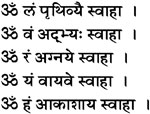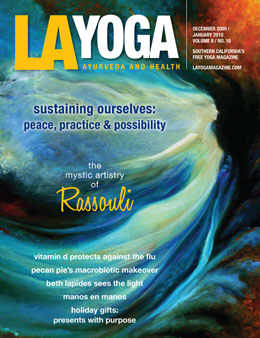Remembering That You And The Planet Are One
We don ’t practice Yoga to escape the world. Rather than drawing away from the changing and challenging world around us, I believe we practice so that we can live powerfully and harmoniously with all existence, regardless of what type of Yoga we do. The word “Yoga” comes from the Sanskrit root yuj, to connect, to yoke, to be in union with. The union we are creating is not something that does not already exist. Yoga is the practice of remembering that we already are connected to something greater than ourselves.
We only have to look at the world around us with yogic eyes to see that our planet is Divinity embodied and she has a name: Prithivi, the Earth Goddess. The Goddess has a husband to whom she is married for all eternity – Vishnu the Sustainer, or he who pervades. Vishnu is the patron deity of Sustainability, the enduring capacity of planetary consciousness. When we lovingly consider the divine marriage of Goddess Prithivi and her husband Vishnu, we can understand the Earth and Sustainability must always be coupled, in order to experience balance.
Sustainable Planet
The feeling of reverence toward the Earth is deeply embodied in the sacred texts. In the Rig Veda, the oldest text of Hinduism, the Earth Mother and Sky Father are given many names in addition to Prithivi and Vishnu.
Mother Nature is also called Aditi (the Source), Ushas (the dawn), and Saraswati (the river mother). The Sky Father is called Indra (sky king), Varuna (lord of the air and waters), Agni (lord of fire), and Dyaus (the Heavens).
Often Prithivi and Vishnu are hymned with praises that celebrate their power as well as their interdependence.
Scholars agree Hindu sacred texts such as the four Vedas are the oldest scriptures of any spiritual tradition that have dedicated passages honoring the Earth. In the Atharva Veda, an entire chapter consisting of sixty-three verses has been devoted to respecting the Earth. Known as the Prithivi Sukta or Earth Verses, they state:
“May the Earth bring us closer to her through her middle-portion, and the energy which resides throughout her body. This land is my mother, I am the son of the Earth. May she nourish, protect, and maintain us in an appropriate manner. The Father is the sky who sustains us with rain.” –– Prithivi Sutka Verse 12 2.62.10, Translated by O.P. Dwivedi
In order to sustain the world and transform negativity and darkness, Vishnu periodically incarnates on Earth in different divine forms called avatars. Vishnu often assumes the bodies of animals, animal-men and human beings. We may be familiar with the playful stories of Krishna, who came as an avatar of love, or the epic fable of Rama, the divine king. In all of his incarnations Vishnu is married to the Earth Mother.
In the Varaha Purana, Vishnu incarnates as the boar avatar, Vahara. At that time, Prithivi, known as Bhudevi (the Earth), was abducted by the negative power of Hiranyaksha, a demonic force who held her captive in the cosmic ocean at the bottom of the universe. Vishnu came as Vahara to fight Hiranyaksha in a thousand-year battle before finally rescuing Bhudevi in the cradle of his tusks and restores her to her proper orbit bringing the universe back into to a Dharmic equilibrium.
The Mystic Meaning
In Yoga there are three sacred marriages.
- The marriage of deities such as Vishnu and Prithivi.
- The cosmic marriage of the Earth with the powerful awareness of Sustainability.
- The “inner” marriage between consciousness and matter (Purusha and Prakriti, respectively), the two aspects of ourselves.
Meditating on these three types of sacred marriage can bring us a little further down the path of Yoga and help us to remember our true nature, our divine nature. Even the English word “nature” has a provocative double entendre. We say our individual being-ness is our nature, and also we speak of the embodied planet as “nature.” Language itself is a further affirmation that we and the planet are one, and there is a continuum of divinity connecting divinity and all life forms.
Sustainable Action
While we all want to do our part for the planet, even as yogis we have a tendency to see these well-intentioned actions as being separate from ourselves. Often while we race around trying to save someone or something we don’t always behave in a sustainable manner.
I have been guilty of teaching so many Yoga classes that I neglect to take the time to practice myself or to take care of my own body. Some of us volunteer so much time for causes we believe in, that we have no time left to spend with our families. I know people who make enormous donations to charities leaving scarcely enough money in their bank accounts to cover their own bills. To find the answer to this, we need to continue to look within and walk our path sustainably.
Bhumi Sparsha Mudra
Despite the irony of our losing touch with sustainability due to an overscheduled Western lifestyle, there is no doubt most modern yogis are motivated by the most excellent of intentions. The actions of practice such as study and service are important facets of the path. But if the way we are seeking is not sustainable; we often crash, get sick, resentful, cynical, and sometimes just stop and give up.
Our experience is not dissimilar to the story of the Lord Buddha, considered by some sources to be the ninth incarnation of Vishnu. The young prince Siddhartha left his kingdom, a veritable palace of delights, and wandered for years before he awakened and became known as the Buddha. During his search, Siddhartha tried everything but became utterly exhausted with his efforts.
Finally, he let go. Calling the Earth as his witness, Siddhartha sat down beneath the great bodhi tree and awakened to his own nature, to the profound realization that everything in the outside world also exists inseparably within. At that moment his hand touched the Earth and, all five fingers of his hand, representing all five elements in the Earth (and all five elements within himself) came together at last.
This hand gesture is known as bhumi sparsha mudra (pictured, left). Energetically it represents the moment when Vishnu (the Sustainer) is reunited with Prithivi (the Earth); the moment when sustainability and the planet are again joined.
It’s not just the work of the avatars and deities to save the Earth and restore order. Because our very flesh, blood and breath makes up the Earth herself, it is also our human responsibility. To achieve a sustainable planet, we must, like Siddhartha, create the causes and conditions that will allow us to realize our own Buddha nature. We must touch the Earth, and find our own “middle path,” taking sustainable actions in a sustainable way.
It is written the tenth avatar of Vishnu, named Kalki, is yet to incarnate and his coming will mark the end of the Kali Yuga, or Dark Age. I’ve often wondered, if Kalki comes in my lifetime, what would he look like? Maybe a CEO arriving on his private jet, blackberry in hand, posting a message of truth on Facebook? Or maybe he’ll appear as a rapper channeling truth through rhythm and vibration? Maybe there is no Kalki out there; and the tenth incarnation is all of us.
Maybe one day we’ll awaken, and recognize that we are the avatar we’ve been waiting for. One day we’ll remember we are all interdependent and that we and the planet are already one.
Sara Elizabeth Ivanhoe is a graduate of the Yoga Philosophy and Yoga and Ecology programs at Loyola Marymount University. She currently teaches at Yoga Works, Santa Monica. Her latest DVD, Yoga on the Edge, is available on her website: yoganation.com. Sara is teaching Holiday Bhakti Flow at the Bhakti Yoga Shala on Saturday, December 5, 1:30 – 3:30 P.M. She is also teaching her seasonal celebration of the Winter Solstice Ritusamhara at Yoga Works Main Street, Friday, December 18, 7:45 – 9:45 P.M.
Sam Diephuis lives in Venice and shoots advertising and editorial imagery. samdiephuis.com
Microcosm Is Macrocosm
When trying to grasp how we are a microcosm of the planet as macrocosm, the philosophy of Samkhya tells us that the Earth is divinity manifested from the five material elements or the panchamahabhuta, identified as: ether, air, fire, water and earth. These five elements constitute the universe and are also the basis of our own physical bodies, sense faculties and mind. The union of Purusa, unembodied consciousness; and Prakriti, embodied nature, is the basis for everything that exists in creation from the most gross to the most subtle.
The earth element makes up the solid part of our physical bodies that we can see, feel, taste and smell. Our physical body also contains water; in fact, the majority of it is water: blood, lymph and other liquids including the fluid inside and surrounding our cells. The digestive fire is the fire element in our bodies (known in Sanskrit as agni), residing in multiple places wherever digestion takes place, including our bellies where the fire breaks down food that we consume and burns off impurities that no longer serve us. We also have agni, distributed in other places, including our mind, where we process sensory perceptions; our cells, where we metabolize and digest and burn off toxins; and in our liver. Our lungs consume the air element and the gases dissolve into our bloodstream and are transported around our body. The air element is a vital part of us; we can live without food for weeks, without water for days, but without air for only a few minutes.

The yogic practice of inner elemental purification, tattva shuddhi, is a recognition of our union with the planet. It helps us to emember that we already are connected, that these elements live within us at all times. Essentially, we are the elements embodied. Tattva Shuddhi is a long and involved ritual that can increase the potency of any of the other yogic practices. A nice way to begin the ritual is by invoking these simple mantras to the five elements.
By Sara Ivanhoe

